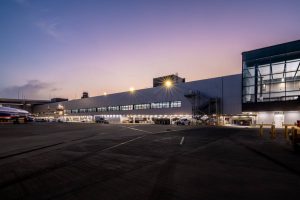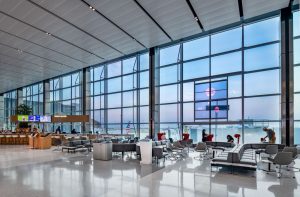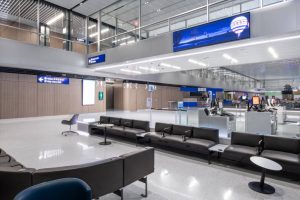Project adds high-tech, sustainable features to DFW Airport terminal extension
by arslan_ahmed | June 26, 2023 5:22 pm
 [1]
[1]The new Terminal D extension at Dallas Fort Worth International Airport (DFW Airport) is designed with sustainability and traveler experience top of mind, with a high-tech, design-forward approach.
luis vidal + architects, creator of some of the world’s top airports, including London’s Heathrow T2, was awarded the design contract in 2018 and serves as the design architect on this project in partnership with HarrisonKornberg Architects and Arup. The project incorporates intelligent design, technology innovations, and intuitive wayfinding to enhance the user experience.
The new terminal offers four new passenger gates and a 13,936-m2 (150,000-sf) concourse, further expanding Terminal D. The new passenger gates include modern concession spaces, hold rooms, a federal inspection/U.S. customs corridor to accommodate international travelers, and a baggage handling extension. The design also accommodates spacious layouts.
 [2]
[2]luis vidal + architects also implemented high-tech glass facades that face the airport’s runways.
One of the key features of the facades was the use of view glass. This technology allows the facade to serve as a communication tool, displaying flight details and airport alerts. In addition, the dynamic glass automatically adjusts in response to the sun to increase access to natural light and views, improving people’s health and wellness by significantly reducing the chances of headaches, eyestrain, and drowsiness caused by exposure to light, while simultaneously saving energy.
 [3]
[3]The intentional placement of floor-to-ceiling windows and the way they introduce natural sunlight will limit the amount of solar radiation exposure the space needs, drastically reducing energy consumption by 15 percent and cutting electricity costs, ultimately meeting the highest of environmental standards and achieving sustainability certifications.
The terminal’s main lounge, neutral-colored and built with wood, ceramic, and terrazzo, is conceived as a single room with no barriers to limit passengers’ field of vision. All seats have their own electric plugs and access to QR codes that connect them to concessions, allowing them to access all services from anywhere in the gate lounge.
Carefully integrated into the design, the new Terminal D extension is equipped with facial recognition and additional high-tech imaging technologies. While many airports currently use thermal imaging, those applications will become more ‘silent’ and less visible, operating off an efficient technological platform that emphasizes personal security and public health.
DFW Airport is the primary international airport serving the Dallas–Fort Worth metroplex area in Texas. It is the largest hub for American Airlines, which is headquartered near the airport. It is also one of the busiest airports in the world. It was named “Global Airport of the Year” by Air Transport World in 2019 and has been recognized by the U.N. and Reuters as one of the world’s global sustainability leaders.
 [4]
[4]“For this design, we infused light, acoustics, texture, and sustainability to create a sophisticated and ‘seamless’ terminal,” says Luis Vidal, founder and president of luis vidal + architects. “Technology, materials, and signage are all carefully integrated to create a space where travelers will feel comfortable, yet still will have direct access to all airport amenities.”
- [Image]: https://www.constructionspecifier.com/wp-content/uploads/2023/06/dfw-airport-exterior-hangar-area.jpeg
- [Image]: https://www.constructionspecifier.com/wp-content/uploads/2023/06/dfw-airport-another-exterior-shot.jpeg
- [Image]: https://www.constructionspecifier.com/wp-content/uploads/2023/06/dfw-ariport-passenger-lounge.jpeg
- [Image]: https://www.constructionspecifier.com/wp-content/uploads/2023/06/dfw-airport-another-passenger-lounge-shot.jpeg
Source URL: https://www.constructionspecifier.com/project-adds-high-tech-sustainable-features-to-dfw-airport-terminal-extension/